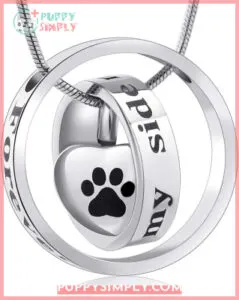This site is supported by our readers. We may earn a commission, at no cost to you, if you purchase through links.

Watch for signs like persistent pain that medication can’t control, difficulty breathing, loss of appetite lasting several days, or frequent accidents indoors. Every dog’s journey is different, but when the bad days outnumber the good ones, you’re facing one of love’s hardest decisions.
Your vet can help assess their condition, but you know your companion best and can recognize subtle changes that signal their readiness. Your ability to notice these changes is crucial in making the decision, as it directly relates to your dog’s readiness for euthanization.
Table Of Contents
- Key Takeaways
- What is Dog Lymphoma?
- Possible Treatments – Should You Fight?
- Best Products for Dogs With Lymphoma
- What Causes Lymphoma in Dogs?
- How Long Does End Stage Lymphoma in Dogs Last?
- What Can I Feed My Dog With Lymphoma?
- Are There Different Types of Lymphoma in Dogs?
- Is My Dog With Lymphoma Suffering?
- Frequently Asked Questions (FAQs)
- Will a dog with Lymphoma die naturally?
- How do you know when to put your dog down with Lymphoma?
- Will my dog die naturally from Lymphoma?
- How do you know when to put down a dog with lymphoma?
- What eventually kills a dog with lymphoma?
- How do I know when my dog has had enough?
- How long does the final stage of lymphoma last in dogs?
- What are the signs of suffering in dogs with lymphoma?
- What is the cost of treatment for canine lymphoma?
- How do I know when the right time to euthanize is?
- Conclusion
Key Takeaways
- Watch for quality of life indicators – You’ll know it’s time when your dog can’t enjoy basic pleasures like eating favorite treats, greeting you at the door, or taking gentle walks, and when bad days outnumber good ones.
- Recognize the warning signs of suffering – Look for persistent pain that medication can’t control, difficulty breathing, loss of appetite lasting several days, frequent accidents indoors, and complete loss of interest in activities they once loved.
- Understand your treatment options before deciding – Chemotherapy can extend life by 8-9 months but costs thousands, while palliative care focuses on comfort using steroids to maintain appetite and energy without aggressive treatment.
- Trust your instincts and work with your vet – You know your companion best and can recognize subtle changes that signal their readiness, but your veterinarian can help assess their medical condition to guide this compassionate decision.
What is Dog Lymphoma?
Dog lymphoma is a cancer affecting your pet’s lymphatic system, which includes lymph nodes, spleen, and bone marrow.
This canine lymphoma represents about 15-20% of all dog cancer diagnoses, making it quite common among older pets.
The disease has unknown causes, though certain breeds show breed predisposition, including Golden Retrievers and Boxers.
Lymphoma in dogs manifests through various lymphoma symptoms like swollen lymph nodes and lethargy.
Understanding this lymphoma overview helps you recognize when your beloved companion may be facing this serious condition.
Possible Treatments – Should You Fight?
When your dog receives a lymphoma diagnosis, you’ll face tough treatment decisions.
Facing lymphoma in your dog means navigating heartbreaking choices with courage and love.
Chemotherapy options like CHOP protocol offer the best remission chances, with 8-9 months average remission time. However, treatment costs can reach thousands of dollars.
Palliative care focuses on comfort rather than cure, using steroids to maintain appetite and energy. Consider your dog’s age, overall health, and quality of life expectations.
Canine lymphoma treatment success varies – some dogs achieve complete remission while others don’t respond well. Discuss all pet lymphoma treatment possibilities with your veterinary oncologist before deciding whether to pursue aggressive cancer treatment options.
Some pet owners are also exploring holistic veterinary medicine to complement conventional treatments.
Best Products for Dogs With Lymphoma
When your dog faces lymphoma, certain products can support their comfort and help you create lasting memories during this difficult time.
These carefully selected items focus on nutritional support for weakened dogs and meaningful ways to honor your pet’s life and legacy.
Grain-Free Chicken Dog Nuggets

When your dog faces lymphoma, nutrition becomes more important than ever. High-quality, easily digestible food can help maintain strength during this challenging time. Primal Pet Foods’ Grain-Free Chicken Nuggets offer exceptional nutrition for dogs battling cancer.
These freeze-dried nuggets contain cage-free chicken raised without antibiotics or hormones. The Grain-Free Benefits include easier digestion and reduced inflammation. Chicken Quality matters – organic, hormone-free protein supports your dog’s immune system. Nugget Ingredients are simple: no corn, wheat, soy, or artificial preservatives.
- Complete and balanced raw nutrition in convenient form
- Easy rehydration with water, bone broth, or goat milk
- Maximum nutrient absorption for weakened systems
- No artificial flavors, colors, or harmful additives
Feeding Guidelines suggest crumbling and rehydrating portions based on your dog’s weight and appetite.
Personalized Pet Memory Box

When facing the heartbreaking reality of pet euthanasia, creating lasting memories becomes essential for healing.
A personalized pet memory box offers comfort during the grieving process and serves as a beautiful tribute to your beloved companion. These carefully crafted keepsakes provide a sacred space for treasured mementos from your dog’s life.
The spacious design accommodates various memorial keepsakes, from ashes and collars to favorite toys and photographs. Custom engraving transforms each box into a unique celebration of your pet’s legacy.
Many grieving families find comfort in adding personal touches through DIY ideas like handwritten letters or special treats.
| Box Contents | Memorial Value | Healing Benefit |
|---|---|---|
| Ashes & Remains | Permanent connection | Provides closure |
| Collar & Tags | Daily life reminders | Preserves identity |
| Photos & Letters | Cherished memories | Supports pet grief recovery |
This thoughtful approach to pet memorialization helps transform overwhelming pet loss into meaningful remembrance, supporting your journey through pet endoflife decisions.
Paw Print Memorial Necklace

Many pet owners find comfort in tangible reminders of their beloved companions when facing difficult decisions about dog lymphoma euthanasia. A paw print memorial necklace offers a beautiful way of memorializing pets while keeping their memory close to your heart.
These meaningful pieces feature durable materials with silver or gold plating options. The design allows you to hold a small portion of ashes or fur inside the pendant, creating a lasting tribute when deciding euthanization lymphoma becomes necessary.
Key features that make these necklaces special:
- Secure lock mechanism prevents accidental opening of the compartment
- Multiple pawprint options accommodate different paw sizes and breeds
- Quality necklace materials guarantee long-lasting wear and durability
- Custom engraving ideas allow personalized necklace sentiments and dates
While some customers report occasional issues with the clasp or pendant weight, most find these memorial pieces provide significant comfort during the grieving process when euthanasia becomes the most compassionate choice.
What Causes Lymphoma in Dogs?
When you’re facing a lymphoma diagnosis for your dog, you’ll naturally wonder what caused this cancer to develop.
Unfortunately, veterinarians haven’t identified a specific cause for lymphoma in dogs, though certain breeds like Golden Retrievers and Boxers show higher risk rates than others.
Common Symptoms of Lymphoma in Dogs
When your dog develops lymphoma, recognizing the warning signs can help you make informed decisions about their care.
The symptoms often appear gradually, making early detection challenging but essential for treatment planning.
Swollen Lymph Nodes represent the most common early indicator.
You’ll feel enlarged lumps under your dog’s jaw, in front of their shoulders, or behind their knees.
These nodes feel firm and moveable under the skin.
Appetite Changes and Weight Loss frequently occur together.
Your dog may show less interest in food or stop eating entirely, leading to noticeable weight reduction over weeks.
Lethargy becomes increasingly apparent as the disease progresses.
Your once-active companion may sleep more, avoid walks, or seem generally uninterested in activities they previously enjoyed.
Breathing Issues can develop, especially with chest-related lymphoma types, causing coughing or labored breathing.
| Symptom Category | Early Signs | Advanced Signs |
|---|---|---|
| Physical Changes | Swollen lymph nodes, mild lethargy | Severe weight loss, visible weakness |
| Eating Habits | Reduced appetite, picky eating | Complete loss of appetite, refusing treats |
| Activity Level | Less playful, shorter walks | Reluctance to move, extended sleeping |
| Digestive Issues | Occasional vomiting, loose stools | Frequent vomiting, chronic diarrhea |
| Respiratory | Mild coughing, slightly labored breathing | Severe breathing difficulties, persistent cough |
These endstage lymphoma symptoms signal your dog’s declining condition and help guide difficult decisions ahead.
Which Dog Breeds Are Predisposed to Lymphoma?
Genetic markers make certain dog breeds more vulnerable to canine lymphoma than others.
Golden Retrievers, Boxers, Scottish Terriers, Bulldogs, and Saint Bernards show higher rates in breed studies.
These breeds carry inherited traits that increase their risk of developing lymphoma in dogs.
Mixed breeds typically face lower risks since they don’t concentrate specific genetic markers.
While environmental factors affect all dogs equally, purebred lines often amplify genetic vulnerabilities.
Understanding your breed’s predisposition helps you watch for early warning signs and develop appropriate prevention strategies.
How Long Does End Stage Lymphoma in Dogs Last?
When your dog reaches end-stage lymphoma, you’re likely wondering how much time you have left together.
Without treatment, dogs typically survive four to six weeks after showing initial symptoms, though some may live slightly longer or shorter depending on their individual condition and the cancer’s progression.
Treating Lymphoma in Dogs
When your dog receives a lymphoma diagnosis, you’ll face treatment decisions that can feel overwhelming.
Chemotherapy protocols offer the most promising path forward, potentially extending your pet’s life by months or even years. Unlike human cancer treatment, dogs typically handle these medications well, experiencing milder treatment side effects like temporary appetite loss rather than severe nausea or hair loss.
Your veterinarian might recommend standard protocols or suggest rescue protocols if initial treatments aren’t effective. Palliative care becomes valuable when aggressive treatment isn’t suitable, focusing on comfort and symptom management.
Dietary support plays a vital role throughout treatment, with easily digestible proteins and omega-3 supplements helping maintain strength. A dog’s median diagnosis age is typically between 6 and 9 years.
Treatment success varies considerably based on lymphoma type, stage, and your dog’s overall health. Regular monitoring helps adjust medications and assess whether continuing treatment maintains good dog lymphoma quality life versus considering more compassionate end-of-life options.
Dog Lymphoma Life Expectancy
Understanding dog lymphoma life expectancy helps you make informed decisions about your pet’s care.
Without treatment, most dogs survive only four to six weeks after diagnosis.
However, Treatment Impact changes this timeline substantially.
Chemotherapy can extend survival to approximately one year, with some dogs living up to two years.
Breed Predisposition affects outcomes, as Golden Retrievers and Boxers may respond differently to therapy.
Age Factors also matter – younger dogs often handle treatment better than senior pets.
Staging Effects influence prognosis too, with early-stage lymphoma offering better survival rates than advanced cases.
When chemotherapy stops working or your dog can’t tolerate it anymore, Palliative Care becomes the focus.
This approach prioritizes comfort over cure, helping you determine the right time for difficult end-of-life decisions while maintaining your dog’s dignity.
What Can I Feed My Dog With Lymphoma?
Proper nutrition becomes your strongest ally when your dog faces lymphoma.
Focus on high-quality protein sources like lean chicken and fish, which support muscle maintenance during treatment.
Supplement options including omega-3 fatty acids can reduce inflammation and boost immune function.
Combat appetite loss with appetite stimulants prescribed by your vet, or try warming food to enhance aroma.
Maintain proper hydration methods through wet food or adding broth to kibble.
High-fat, low-carb diets can also be beneficial for dogs with cancer, as seen in this High-fat, low-carb diets.
While homemade diets require careful planning, commercial therapeutic foods often provide balanced canine nutrition for dogs battling lymphoma symptoms.
Are There Different Types of Lymphoma in Dogs?
When your dog receives a lymphoma diagnosis, you’ll learn that this cancer isn’t just one disease but actually includes over 30 different forms that affect various parts of your pet’s body.
Understanding the four main types that commonly occur in dogs—multicentric, alimentary, mediastinal, and extranodal lymphoma—helps you make informed decisions about treatment options and your dog’s care plan.
Multicentric Lymphoma
When you’re dealing with lymphoma types, multicentric lymphoma stands as the heavyweight champion—accounting for 80-85% of all canine lymphoma cases.
This aggressive form targets multiple lymph nodes throughout your dog’s body, creating a systemic battle that’s hard to ignore.
Your dog’s Lymph Node Impact becomes immediately visible as painless swellings appear under the jaw, in front of the shoulders, and behind the knees.
Unlike other cancers that hide, multicentric lymphoma announces itself boldly.
Breed Predisposition plays a significant role here—Golden Retrievers, Boxers, and Labrador Retrievers face higher risks.
Staging Implications determine everything.
Stage I affects one lymph node, while Stage V infiltrates bone marrow and nervous system.
Treatment Response varies dramatically between B-cell and T-cell variants, with B-cell showing better outcomes.
Survival Rates with chemotherapy average one year, though some dogs live longer.
When lymphoma endstage signs appear—complete appetite loss, labored breathing, incontinence—deciding euthanasia lymphoma becomes a compassionate choice to prevent lymphoma dog suffering.
Alimentary Lymphoma
While multicentric lymphoma affects lymph nodes throughout your dog’s body, alimentary lymphoma takes a different approach by targeting the digestive system.
This form accounts for only 5-7% of canine lymphoma cases but presents unique diagnosis challenges that can frustrate both owners and veterinarians.
Intestinal symptoms include persistent vomiting, diarrhea, and dramatic weight loss that doesn’t respond to typical treatments.
Your dog might seem hungry but can’t keep food down, creating a heartbreaking cycle.
These signs often mimic other digestive issues, making early detection difficult.
Treatment options for alimentary lymphoma typically involve chemotherapy, though the dog lymphoma prognosis remains guarded compared to other types.
Nutritional management becomes critical—easily digestible proteins and frequent small meals can help.
When considering deciding euthanasia lymphoma cases, watch for signs of lymphoma dog suffering, including complete appetite loss and constant digestive distress that impacts their quality of life substantially.
Mediastinal Lymphoma
Mediastinal lymphoma strikes where your dog needs it least—the chest cavity.
This aggressive form targets lymph nodes around the heart and lungs, often involving thymus involvement that creates serious complications.
You’ll notice breathing difficulty as the first red flag, followed by visible chest masses that press against essential organs.
Unlike other lymphoma types, mediastinal lymphoma moves fast and hits hard.
Fluid accumulation in the chest cavity compounds the breathing problems, making every breath a struggle for your pup.
The location makes this particularly devastating since it directly impacts your dog’s ability to breathe normally.
Treatment options exist, but they’re often less effective than with other lymphoma forms.
When deciding euthanasia lymphoma cases, mediastinal presents unique challenges.
The rapid progression and breathing complications mean you’ll need to make the pet euthanasia decision sooner rather than later.
When to euthanize dog becomes clearer when quality breathing becomes impossible.
Extranodal Lymphoma
Extranodal lymphoma represents the wild card in canine cancer—it’s the rarest form, showing up in unexpected places throughout your dog’s body.
Unlike other types that stick to lymph nodes, this sneaky variant targets organs like the skin, kidneys, eyes, or even the brain.
Rare Locations make diagnostic challenges significant.
Your vet might spot red, itchy skin lesions, kidney problems, or vision changes.
Each location demands specific treatments customized to where the cancer strikes.
Prognosis factors vary wildly depending on the affected organ and whether it’s B-cell or T-cell lymphoma.
Skin involvement often responds better than internal organs.
Research advances continue improving outcomes, but honestly, extranodal lymphoma keeps everyone guessing.
When deciding euthanasia lymphoma cases, location matters enormously.
Brain involvement might prompt earlier when to euthanize dog conversations than skin lesions.
Dog cancer euthanasia timing depends on your pet’s specific situation and quality of life.
Is My Dog With Lymphoma Suffering?
Recognizing when your dog with lymphoma is suffering requires careful observation of specific symptoms and changes in behavior.
You’ll need to watch for signs like complete loss of appetite, labored breathing, inability to move comfortably, and loss of interest in activities they once enjoyed.
When to Euthanize a Dog With Lymphoma
Making the decision about euthanasia for your dog with lymphoma involves careful consideration of several key factors.
You’ll need to assess suffering signs like loss of appetite, difficulty breathing, and inability to enjoy daily activities.
Quality assessment becomes your primary guide – if your dog can’t engage in favorite activities or seems constantly uncomfortable, it may be time.
Consider hospice options as an alternative to aggressive treatment, focusing on comfort rather than cure.
The financial burden of ongoing treatment shouldn’t overshadow your pet’s wellbeing, but it’s a legitimate concern.
Family impact matters too – watching a beloved companion struggle affects everyone.
One consideration is that lymphoma can sometimes impact kidney function, so be aware of increased thirst symptoms.
When deciding euthanasia lymphoma cases, ask yourself: Is your dog having more bad days than good?
Lymphoma ethical considerations center on preventing unnecessary suffering.
The pet euthanasia decision ultimately comes down to love – sometimes letting go is the kindest gift you can give.
How Does Dog Euthanasia Work?
Understanding the euthanasia process helps ease your worries during this difficult time.
Your veterinarian will guide you through each step with compassion and professionalism.
Here’s what typically happens during the procedure:
- Consultation – Your vet discusses the pet euthanasia decision and addresses your concerns
- Sedation – A mild sedative may be given first to keep your dog calm
- Injection – Sodium pentobarbital, a powerful anesthetic drug, is administered intravenously
- Peaceful passing – Heart stoppage occurs within seconds, causing no pain
- Aftercare – Grief support and body care options are discussed
To guarantee a comfortable experience, some owners explore additional calming aids before the procedure.
How to Evaluate Quality of Life in a Dog With Cancer
Once you’ve learned about the euthanasia process, you’ll need practical tools to assess your dog’s current situation.
Evaluating quality of life in a dog with lymphoma requires looking beyond medical reports to understand your pet’s daily experience.
Start by observing specific areas that matter most to your companion’s wellbeing:
| Quality of Life Factor | What to Watch For |
|---|---|
| Appetite Changes | Refusing favorite foods, eating less than 50% of normal portions |
| Mobility Issues | Struggling to stand, reluctance to walk, avoiding stairs |
| Pain Management | Panting excessively, restlessness, hiding, whimpering |
| Social Interaction | Avoiding family members, no interest in petting or play |
| Mental Wellbeing | Confusion, staring blankly, loss of house training |
These observations help you make informed end-of-life decisions about canine lymphoma.
Loss of appetite is common, but a dog appetite stimulant may help in some cases.
Your dog’s pet quality of life depends on their ability to enjoy simple pleasures without overwhelming discomfort.
Frequently Asked Questions (FAQs)
Will a dog with Lymphoma die naturally?
Max, a Golden Retriever, lived six weeks after his lymphoma diagnosis without treatment.
Yes, your dog can die naturally from lymphoma, but they’ll likely suffer substantially during those final weeks without intervention.
How do you know when to put your dog down with Lymphoma?
Watch for signs your dog’s stopped enjoying life: refusing food for days, struggling to breathe, constant pain, or losing control of basic functions.
When comfort becomes impossible, euthanasia prevents unnecessary suffering.
Will my dog die naturally from Lymphoma?
Yes, your dog will likely die naturally from lymphoma if left untreated.
Most dogs survive only four to six weeks without treatment, though some may live slightly longer or shorter depending on their condition.
How do you know when to put down a dog with lymphoma?
Consider euthanasia when your dog shows complete loss of appetite, labored breathing, incontinence, constant discomfort, or can’t enjoy daily activities.
Consult your veterinarian to assess quality of life and make this difficult decision together.
What eventually kills a dog with lymphoma?
Like a wildfire consuming dry grass, lymphoma spreads relentlessly through your dog’s body.
Eventually, organ failure, severe anemia, or overwhelming infection claims their life as the cancer destroys their immune system’s ability to function, leading to a point where the cancer has completely taken over, causing severe anemia.
How do I know when my dog has had enough?
Your dog signals they’ve had enough when they stop eating, struggle to breathe, can’t control their bladder, or show constant discomfort.
Trust your instincts and consult your vet about their quality of life.
How long does the final stage of lymphoma last in dogs?
Ironically, while we desperately seek exact timelines, the final stage typically lasts just 2-6 weeks without treatment.
You’ll notice rapid decline with severe symptoms like breathing difficulties, complete appetite loss, and profound weakness signaling the end approaches, which includes severe symptoms.
What are the signs of suffering in dogs with lymphoma?
Watch for complete loss of appetite, labored breathing, daily lethargy, frequent vomiting, inability to control bladder or bowels, restlessness, unwillingness to move, and obvious discomfort that pain medication can’t relieve.
What is the cost of treatment for canine lymphoma?
Chemotherapy treatment for your dog’s lymphoma typically costs $3,000-$8,000 total. Individual sessions range from $200-$500 each. Diagnostic tests add $500-$1, Many veterinary clinics offer payment plans to help manage expenses.
How do I know when the right time to euthanize is?
Like a compass guiding through dark waters, your dog’s quality of life points the way.
When they can’t eat, play, or find comfort despite medication, their eyes tell you it’s time to let go.
Conclusion
Remarkably, many pet owners discover their strength to make this difficult decision when they least expect it.
Deciding dog lymphoma when to euthanize requires courage, compassion, and trust in your bond with your companion.
You’ve provided love, care, and comfort throughout their journey.
When treatment no longer improves their quality of life, choosing peaceful euthanasia becomes your final act of love.
Your veterinarian will guide you through this process with dignity and understanding during this challenging time.
- https://vcahospitals.com/know-your-pet/lymphoma-in-dogs
- https://en.wikipedia.org/wiki/Dog_behavior
- https://caringpathways.com/wp-content/uploads/2018/02/QualityofLifeScale.pdf
- https://www.lapoflove.com/
- https://www.peacefulpetgoodbyes.uk/lymphoma-in-dogs-dog-lymphoma-symptoms-treatments-and-lymphoma-life-expectancy-in-dogs/











